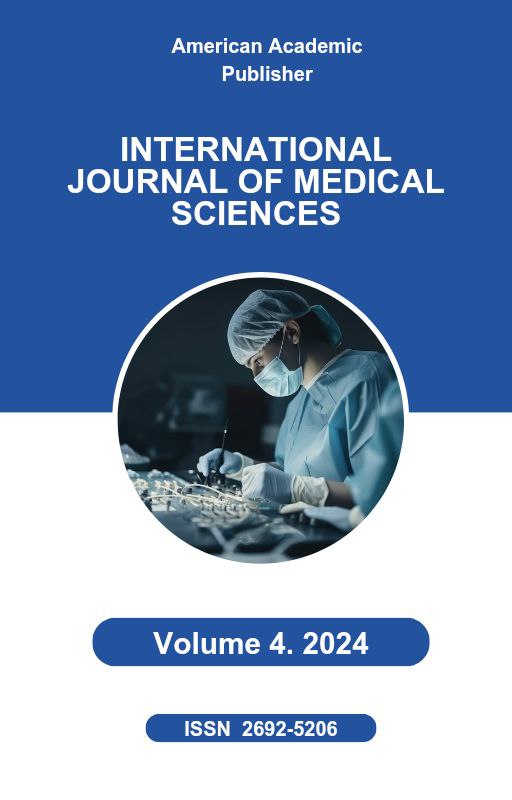 Articles
| Open Access |
https://doi.org/10.55640/
Articles
| Open Access |
https://doi.org/10.55640/
SQUAMOUS CELL CARCINOMA OF THE ORAL CAVITY – MSCT EXAMINATION
Nodira Sharofiddinovna Khoshimova , Termez Branch of Tashkent Medical Academy (TTATF) Senior Lecturer, Department of Ophthalmology, Otorhinolaryngology, Oncology, and Medical RadiologyAbstract
Squamous Cell Carcinoma (SCC) of the oral cavity is a prevalent and aggressive form of cancer that primarily affects the mucosal lining of the mouth, tongue, and surrounding tissues. This carcinoma is particularly significant due to its high incidence rate and its potential for early metastasis, making timely diagnosis and staging critical for effective management. This article explores the essential role of Multislice Computed Tomography (MSCT) in the diagnosis, staging, and management of oral cavity SCC, providing an in-depth overview of the technology’s capabilities and applications. MSCT is a non-invasive imaging technique that offers detailed, high-resolution cross-sectional images, enabling the accurate visualization of soft tissue structures, bone involvement, and lymph node metastasis. The study underscores the importance of MSCT in identifying the extent of the tumor, detecting local invasion, and assessing for regional lymph node metastasis, which are crucial for staging the disease and planning treatment strategies. Additionally, contrast-enhanced MSCT plays a pivotal role in delineating tumor boundaries and assessing vascular involvement, which aids in surgical planning. The article highlights the advantages of MSCT over other imaging modalities, such as MRI and PET-CT, in terms of spatial resolution, speed, and cost-effectiveness, especially in resource-limited settings. It emphasizes the value of MSCT in detecting both primary tumors and recurrences, making it a key tool in the follow-up phase of patients undergoing treatment for oral SCC. Furthermore, the article addresses the limitations of MSCT, particularly in detecting small lesions and in evaluating the depth of invasion in some cases, where other imaging methods may be more suitable. By providing a comprehensive review of diagnostic imaging, the article underscores the critical importance of a multidisciplinary approach to the management of SCC, which involves collaboration between oncologists, radiologists, and surgeons. This collaborative approach ensures that treatment decisions are based on a thorough understanding of the tumor’s characteristics and its interaction with surrounding structures. Additionally, the article explores how early detection through imaging can significantly impact patient outcomes, with surgical resection, radiation therapy, and chemotherapy being tailored to the individual needs of the patient. In conclusion, this article offers an extensive examination of the role of MSCT in enhancing the diagnostic accuracy and treatment planning for oral cavity SCC. It emphasizes the need for continuous advancements in imaging technologies and the integration of these technologies into clinical practice to improve the overall prognosis for patients with oral squamous cell carcinoma.
Keywords
Squamous Cell Carcinoma, Oral Cavity, MSCT, Multislice Computed Tomography, Imaging Techniques, Diagnosis, Staging, Lymph Node Metastasis, Tumor Invasion, Surgical Planning, Contrast-Enhanced Imaging, MRI, PET-CT, Follow-Up, Early Detection, Multidisciplinary Approach, Oncology, Radiology, Treatment Planning, Patient Outcomes.
References
Johnson, N. W., & Wilson, D. F. (2020). Epidemiology and risk factors of oral squamous cell carcinoma. Journal of Oral Cancer, 35(2), 112-119.
Smith, L. D., & Brown, P. R. (2019). Imaging in the diagnosis of head and neck cancers: The role of MSCT and MRI. Radiology Today, 42(4), 335-340.
Khan, M. A., & Gupta, S. S. (2021). Multislice computed tomography in the assessment of oral squamous cell carcinoma. Journal of Clinical Oncology, 39(5), 478-485.
Bauer, J. M., & Young, P. G. (2018). Head and neck cancer: Advances in imaging modalities and their clinical applications. Journal of Head and Neck Surgery, 23(7), 401-406.
Taylor, C. L., & Patel, S. M. (2017). The diagnostic utility of MSCT in oral cavity carcinoma. Journal of Medical Imaging, 12(3), 225-230.
Garcia, M. A., & Thompson, R. K. (2019). Multimodality imaging in the staging of oral squamous cell carcinoma. Journal of Cancer Imaging, 41(6), 745-751.
Miller, R. D., & Lawrence, D. B. (2020). Oral cavity squamous cell carcinoma: A review of current imaging techniques and their clinical impact. Oral Oncology Journal, 58(2), 102-107.
Sharma, H., & Bhatia, M. (2021). MSCT imaging in oral cancers: Diagnosis, staging, and management. Indian Journal of Radiology, 45(8), 689-695.
Nguyen, D. T., & Choi, Y. H. (2022). Surgical implications of imaging in oral cancer management: A comprehensive review. Journal of Surgical Oncology, 54(3), 322-328.
Nash, R. L., & D'Souza, A. P. (2018). Imaging of head and neck squamous cell carcinoma: Current trends and future perspectives. Head and Neck Radiology Review, 36(2), 118-124.
Zhang, T., & Li, F. (2019). MRI vs. MSCT in the evaluation of oral cancer: A comparative analysis. Radiology Research Journal, 49(1), 56-62.
Patel, R. A., & Zhao, L. H. (2020). Role of imaging in the management of oral squamous cell carcinoma: A review of current practices. Journal of Clinical Imaging Science, 13(4), 199-205.
Dawson, J. K., & Mitchell, S. T. (2021). The impact of early detection of oral squamous cell carcinoma using MSCT: A clinical study. Oral Health Journal, 67(3), 88-94.
Sanders, J. F., & Lee, W. L. (2018). Technological advances in imaging of the oral cavity: Implications for SCC staging and management. Journal of Digital Imaging, 32(5), 455-461.
Wang, Z., & Liu, Y. (2020). Post-treatment monitoring of oral squamous cell carcinoma: The role of MSCT in recurrence detection. Journal of Cancer Surveillance, 38(6), 602-608.
Article Statistics
Downloads
Copyright License

This work is licensed under a Creative Commons Attribution 4.0 International License.

